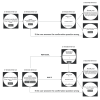mHealth-Based Just-in-Time Adaptive Intervention to Improve the Physical Activity Levels of Individuals With Spinal Cord Injury: Protocol for a Randomized Controlled Trial
- PMID: 38941145
- PMCID: PMC11245659
- DOI: 10.2196/57699
mHealth-Based Just-in-Time Adaptive Intervention to Improve the Physical Activity Levels of Individuals With Spinal Cord Injury: Protocol for a Randomized Controlled Trial
Abstract
Background: The lack of regular physical activity (PA) in individuals with spinal cord injury (SCI) in the United States is an ongoing health crisis. Regular PA and exercise-based interventions have been linked with improved outcomes and healthier lifestyles among those with SCI. Providing people with an accurate estimate of their everyday PA level can promote PA. Furthermore, PA tracking can be combined with mobile health technology such as smartphones and smartwatches to provide a just-in-time adaptive intervention (JITAI) for individuals with SCI as they go about everyday life. A JITAI can prompt an individual to set a PA goal or provide feedback about their PA levels.
Objective: The primary aim of this study is to investigate whether minutes of moderate-intensity PA among individuals with SCI can be increased by integrating a JITAI with a web-based PA intervention (WI) program. The WI program is a 14-week web-based PA program widely recommended for individuals with disabilities. A secondary aim is to investigate the benefit of a JITAI on proximal PA, defined as minutes of moderate-intensity PA within 120 minutes of a PA feedback prompt.
Methods: Individuals with SCI (N=196) will be randomized to a WI arm or a WI+JITAI arm. Within the WI+JITAI arm, a microrandomized trial will be used to randomize participants several times a day to different tailored feedback and PA recommendations. Participants will take part in the 24-week study from their home environment in the community. The study has three phases: (1) baseline, (2) WI program with or without JITAI, and (3) PA sustainability. Participants will provide survey-based information at the initial meeting and at the end of weeks 2, 8, 16, and 24. Participants will be asked to wear a smartwatch every day for ≥12 hours for the duration of the study.
Results: Recruitment and enrollment began in May 2023. Data analysis is expected to be completed within 6 months of finishing participant data collection.
Conclusions: The JITAI has the potential to achieve long-term PA performance by delivering tailored, just-in-time feedback based on the person's actual PA behavior rather than a generic PA recommendation. New insights from this study may guide intervention designers to develop engaging PA interventions for individuals with disability.
Trial registration: ClinicalTrials.gov NCT05317832; https://clinicaltrials.gov/study/NCT05317832.
International registered report identifier (irrid): DERR1-10.2196/57699.
Keywords: community; ecological momentary assessment; just-in-time adaptive intervention; microrandomized trial; mobile health; mobile phone; physical activity; randomized controlled trial; spinal cord injury; wearable sensors.
©Rachel L Carey, Ha Le, Donna L Coffman, Inbal Nahum-Shani, Mohanraj Thirumalai, Cole Hagen, Laura A Baehr, Mary Schmidt-Read, Marlyn S R Lamboy, Stephanie A Kolakowsky-Hayner, Ralph J Marino, Stephen S Intille, Shivayogi V Hiremath. Originally published in JMIR Research Protocols (https://www.researchprotocols.org), 28.06.2024.
Conflict of interest statement
Conflicts of Interest: None declared.
Figures










Similar articles
-
Mobile health-based physical activity intervention for individuals with spinal cord injury in the community: A pilot study.PLoS One. 2019 Oct 15;14(10):e0223762. doi: 10.1371/journal.pone.0223762. eCollection 2019. PLoS One. 2019. PMID: 31613909 Free PMC article. Clinical Trial.
-
Smartphone App Delivery of a Just-In-Time Adaptive Intervention for Adult Gamblers (Gambling Habit Hacker): Protocol for a Microrandomized Trial.JMIR Res Protoc. 2022 Jul 26;11(7):e38919. doi: 10.2196/38919. JMIR Res Protoc. 2022. PMID: 35881441 Free PMC article.
-
Physical Activity With Tailored mHealth Support for Individuals With Intellectual Disabilities: Protocol for a Randomized Controlled Trial.JMIR Res Protoc. 2020 Jun 29;9(6):e19213. doi: 10.2196/19213. JMIR Res Protoc. 2020. PMID: 32437328 Free PMC article.
-
Digital technology for delivering and monitoring exercise programs for people with cystic fibrosis.Cochrane Database Syst Rev. 2023 Jun 9;6(6):CD014605. doi: 10.1002/14651858.CD014605.pub2. Cochrane Database Syst Rev. 2023. PMID: 37294546 Free PMC article. Review.
-
Personalized interventions for behaviour change: A scoping review of just-in-time adaptive interventions.Br J Health Psychol. 2025 Feb;30(1):e12766. doi: 10.1111/bjhp.12766. Epub 2024 Nov 14. Br J Health Psychol. 2025. PMID: 39542743 Free PMC article.
Cited by
-
Implementation of Behavior Change Theories and Techniques for Physical Activity Just-in-Time Adaptive Interventions: A Scoping Review.Int J Environ Res Public Health. 2025 Jul 17;22(7):1133. doi: 10.3390/ijerph22071133. Int J Environ Res Public Health. 2025. PMID: 40724199 Free PMC article.
References
-
- Traumatic spinal cord injury facts and figures at a glance. National Spinal Cord Injury Statistical Center. 2023. [2024-06-01]. https://www.nscisc.uab.edu/public/Facts%20and%20Figures%202024%20-%20Fin... . - PubMed
-
- The 2022 annual statistical report complete public version for the spinal cord injury model systems. National Spinal Cord Injury Statistical Center. 2022. [2024-06-01]. https://www.nscisc.uab.edu/public/AR2022_public%20version.pdf .
-
- Tawashy AE, Eng JJ, Lin KH, Tang PF, Hung C. Physical activity is related to lower levels of pain, fatigue and depression in individuals with spinal-cord injury: a correlational study. Spinal Cord. 2009 Apr;47(4):301–6. doi: 10.1038/sc.2008.120. https://europepmc.org/abstract/MED/18936771 sc2008120 - DOI - PMC - PubMed
Publication types
MeSH terms
Associated data
Grants and funding
LinkOut - more resources
Full Text Sources
Medical

